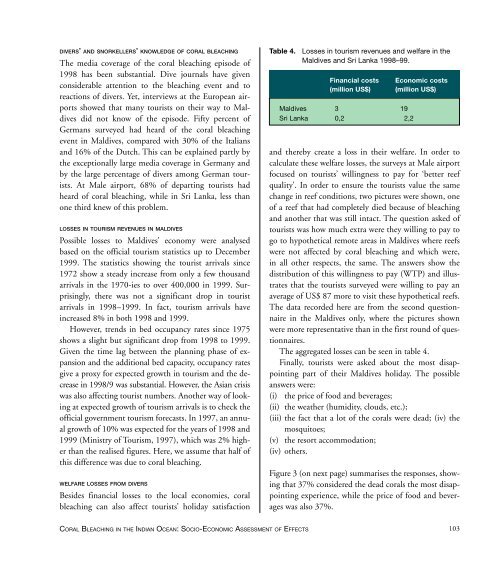You also want an ePaper? Increase the reach of your titles
YUMPU automatically turns print PDFs into web optimized ePapers that Google loves.
DIVERS’ AND SNORKELLERS’ KNOWLEDGE OF CORAL BLEACHING<br />
The media coverage <strong>of</strong> the coral bleaching episode <strong>of</strong><br />
1998 has been substantial. Dive journals have given<br />
considerable attention to the bleaching event and to<br />
reactions <strong>of</strong> divers. Yet, interviews at the European airports<br />
showed that many tourists on their way to Maldives<br />
did not know <strong>of</strong> the episode. Fifty percent <strong>of</strong><br />
Germans surveyed had heard <strong>of</strong> the coral bleaching<br />
event in Maldives, compared with 30% <strong>of</strong> the Italians<br />
and 16% <strong>of</strong> the Dutch. This can be explained partly by<br />
the exceptionally large media coverage in Germany and<br />
by the large percentage <strong>of</strong> divers among German tourists.<br />
At Male airport, 68% <strong>of</strong> departing tourists had<br />
heard <strong>of</strong> coral bleaching, while in Sri Lanka, less than<br />
one third knew <strong>of</strong> this problem.<br />
LOSSES IN TOURISM REVENUES IN MALDIVES<br />
Possible losses to Maldives’ economy were analysed<br />
based on the <strong>of</strong>ficial tourism statistics up to December<br />
1999. The statistics showing the tourist arrivals since<br />
1972 show a steady increase from only a few thousand<br />
arrivals in the 1970-ies to over 400,000 in 1999. Surprisingly,<br />
there was not a significant drop in tourist<br />
arrivals in 1998–1999. In fact, tourism arrivals have<br />
increased 8% in both 1998 and 1999.<br />
However, trends in bed occupancy rates since 1975<br />
shows a slight but significant drop from 1998 to 1999.<br />
Given the time lag between the planning phase <strong>of</strong> expansion<br />
and the additional bed capacity, occupancy rates<br />
give a proxy for expected growth in tourism and the decrease<br />
in 1998/9 was substantial. However, the Asian crisis<br />
was also affecting tourist numbers. Another way <strong>of</strong> looking<br />
at expected growth <strong>of</strong> tourism arrivals is to check the<br />
<strong>of</strong>ficial government tourism forecasts. In 1997, an annual<br />
growth <strong>of</strong> 10% was expected for the years <strong>of</strong> 1998 and<br />
1999 (Ministry <strong>of</strong> Tourism, 1997), which was 2% higher<br />
than the realised figures. Here, we assume that half <strong>of</strong><br />
this difference was due to coral bleaching.<br />
WELFARE LOSSES FROM DIVERS<br />
Besides financial losses to the local economies, coral<br />
bleaching can also affect tourists’ holiday satisfaction<br />
Table 4.<br />
Losses in tourism revenues and welfare in the<br />
Maldives and Sri Lanka 1998–99.<br />
Financial costs<br />
(million US$)<br />
Maldives 3 19<br />
Sri Lanka 0,2 2,2<br />
Economic costs<br />
(million US$)<br />
and thereby create a loss in their welfare. In order to<br />
calculate these welfare losses, the surveys at Male airport<br />
focused on tourists’ willingness to pay for ‘better reef<br />
quality’. In order to ensure the tourists value the same<br />
change in reef conditions, two pictures were shown, one<br />
<strong>of</strong> a reef that had completely died because <strong>of</strong> bleaching<br />
and another that was still intact. The question asked <strong>of</strong><br />
tourists was how much extra were they willing to pay to<br />
go to hypothetical remote areas in Maldives where reefs<br />
were not affected by coral bleaching and which were,<br />
in all other respects, the same. The answers show the<br />
distribution <strong>of</strong> this willingness to pay (WTP) and illustrates<br />
that the tourists surveyed were willing to pay an<br />
average <strong>of</strong> US$ 87 more to visit these hypothetical reefs.<br />
The data recorded here are from the second questionnaire<br />
in the Maldives only, where the pictures shown<br />
were more representative than in the first round <strong>of</strong> questionnaires.<br />
The aggregated losses can be seen in table 4.<br />
Finally, tourists were asked about the most disappointing<br />
part <strong>of</strong> their Maldives holiday. The possible<br />
answers were:<br />
(i) the price <strong>of</strong> food and beverages;<br />
(ii) the weather (humidity, clouds, etc.);<br />
(iii) the fact that a lot <strong>of</strong> the corals were dead; (iv) the<br />
mosquitoes;<br />
(v) the resort accommodation;<br />
(iv) others.<br />
Figure 3 (on next page) summarises the responses, showing<br />
that 37% considered the dead corals the most disappointing<br />
experience, while the price <strong>of</strong> food and beverages<br />
was also 37%.<br />
CORAL BLEACHING IN THE INDIAN OCEAN: SOCIO-ECONOMIC ASSESSMENT OF EFFECTS<br />
103


















